A Visualized Experimental Study on the Influence of Reflux Hole on the Double Blades Self-Priming Pump Performance
Abstract
:1. Introduction
2. Experimental Facility and Method
3. Results
3.1. Influence of Different Reflux Hole Position on Water Level Change during Self-Priming Process
3.2. Influence of Different Reflux Hole Positions on Gas–Liquid Two-Phase Flow Pattern
3.3. Influence of Different Reflux Hole Area on Water Level Change during Self-Priming Process
3.4. Influence of Different Reflux Hole Area on Gas–Liquid Two-Phase Flow Pattern
4. Conclusions
- (1)
- The research fully proved that the change of the reflux hole structure parameters affects the self-priming performance of the self-priming pump by affecting the gas–liquid two-phase backflow rate during the self-priming process.
- (2)
- Since the outlet of the volute was not vertically upward, there was a lateral component velocity when liquid flowed out of the volute, which led to the uneven distribution of the pump body velocity. Therefore, the reflux hole in different positions will lead to the change of gas–liquid two-phase back flow rate in the pump chamber, thus affecting the self-priming pump performance. In this study, the self-priming performance was best when reflux hole was at +15°, and worst when reflux hole was at −30°.
- (3)
- The area of the reflux hole mainly affected the composition of the backflow gas–liquid mixture in the pump. With the increase of the area of the reflux hole, the self-priming time of the centrifugal pump first decreased and then increased; an excessively large reflux hole increased the gas flow back, while a too-small reflux hole limited the liquid flow back hole. The optimal diameter of the reflux hole in this study was d = 10 mm.
- (4)
- In the diffuser of the volute, as the area of the reflux hole decreased, the area of stagnant swirling bubbles expanded. Tracing specific bubbles showed that due to the structure of the volute, the stagnant swirling bubbles are mainly concentrated on the right side of the diffuser.
- (5)
- Although this paper fully revealed the gas–liquid two-phase flow pattern in the pump during the self-priming process, due to lots of bubbles in the pump, serious overlap, and small volume, the evolution characteristics of the bubbles during the self-priming process were not quantitatively analyzed. Bubble image processing and analysis can be the main content of subsequent research.
Author Contributions
Funding
Institutional Review Board Statement
Informed Consent Statement
Data Availability Statement
Conflicts of Interest
References
- Zhang, Y.; Zhu, Z.; Zhao, Y.; Wu, J.; Zhou, F. Comparative experiments on a self-priming pump delivering water medium during rapid and slow starting periods. Iran. J. Sci. Technol. Trans. Mech. Eng. 2020, 45, 1007–1019. [Google Scholar] [CrossRef]
- Wu, D.; Zhu, Z.; Ren, Y.; Gu, Y.; Zhou, P. Influence of blade profile on energy loss of sewage self-priming pump. J. Braz. Soc. Mech. Sci 2019, 41, 470. [Google Scholar] [CrossRef]
- Yao, H.; Zhang, Y.; Wu, D.; Wu, P. Numerical study on hydraulic and self-priming performance of a double-stage self-priming pump. IOP Conf. Ser. Earth Environ. Sci. 2018, 163, 012039. [Google Scholar] [CrossRef]
- He, C.; Gu, Y.; Zhang, J.; Ma, L.; Yan, M.; Mou, J.; Ren, Y. Preparation and modification technology analysis of Ionic Polymer-Metal Composites (IPMCs). Int. J. Mol. Sci. 2022, 23, 3522. [Google Scholar] [CrossRef] [PubMed]
- Gu, Y.; Yu, L.; Mou, J.; Wu, D.; Xu, M.; Zhou, P.; Ren, Y. Research strategies to develop environmentally friendly marine antifouling coatings. Mar. Drugs 2020, 18, 371. [Google Scholar] [CrossRef] [PubMed]
- Mou, J.; Zhang, F.; Wang, H.; Wu, D. Influence of the area of the reflux hole on the performance of a self-priming pump. Fluid Dyn. Mater. Proc. 2019, 15, 187–205. [Google Scholar] [CrossRef]
- Kim, S.; Sohn, C.; Hwang, J. Effects of tube diameter and submergence ratio on bubble pattern and performance of air-lift pump. Int. J. Multiphas Flow 2014, 58, 195–204. [Google Scholar] [CrossRef]
- Shao, C.; Li, C.; Zhou, J. Experimental investigation of flow patterns and external performance of a centrifugal pump that transports gas-liquid two-phase mixtures. Int. J. Heat Fluid Flow 2018, 71, 460–469. [Google Scholar] [CrossRef]
- Stel, H.; Ofuchi, E.; Sabino, R.; Ancajima, F.; Bertoldi, D.; Neto, M.; Morales, R. Investigation of the motion of bubbles in a centrifugal pump impeller. J. Fluid Eng. 2019, 141, 031203. [Google Scholar] [CrossRef]
- Barrios, L.; Prado, M. Experimental Visualization of two-phase flow inside an electrical submersible pump stage. J. Energ. Resour. 2011, 133, 042901. [Google Scholar] [CrossRef]
- Barrios, L.; Prado, M. Modeling two-phase flow inside an electrical submersible pump stage. J. Energ. Resour. 2011, 133, 042902. [Google Scholar] [CrossRef]
- Verde, W.; Biazussi, J.; Sassim, N.; Bannwart, A. Experimental study of gas-liquid two-phase flow patterns within centrifugal pumps impellers. Exp. Therm. Fluid Sci. 2017, 85, 37–51. [Google Scholar] [CrossRef]
- Zhang, J.; Cai, S.; Zhu, H.; Zhang, Y. Experimental investigation of the flow at the entrance of a rotodynamic multiphase pump by visualization. J. Petrol. Sci. Eng. 2015, 126, 254–261. [Google Scholar] [CrossRef]
- Shu, X.; Ren, Y.; Wu, D.; Zhu, Z.; Mou, J. Energy loss and unsteady flow characteristics in a self-priming pump. J. Hydraul. Eng. 2019, 50, 1010–1020. [Google Scholar]
- Wang, C.; Hu, B.; Zhu, Y.; Wang, X.; Luo, C.; Cheng, L. Numerical study on the gas-water two-phase flow in the self-priming process of self-priming centrifugal pump. Processes 2019, 7, 330. [Google Scholar] [CrossRef] [Green Version]
- Wang, C.; He, X.; Zhang, D.; Hu, B.; Shi, W. Numerical and experimental study of the self-priming process of a multistage self-priming centrifugal pump. Int. J. Energy Res. 2019, 43, 4074–4092. [Google Scholar] [CrossRef]
- Cheng, X.; Wang, J.; Liu, M. Influence of reflux hole position and area on performance of vertical self-priming pump. J. Huazhong Univ. Sci.Tech. 2022, 50, 63–68. [Google Scholar]
- Qian, H.; Mou, J.; Ren, Y.; Zhu, Z.; Liu, N.; Zheng, S.; Wu, D. Investigation of self-priming process of a centrifugal pump with double blades. J. Therm. Sci. 2021, 30, 849–858. [Google Scholar] [CrossRef]
- Chang, H.; Shi, W.; Li, W.; Liu, J. Energy loss analysis of novel self-priming pump based on the entropy production theory. J. Therm. Sci. 2019, 28, 306–318. [Google Scholar] [CrossRef]
- Li, G.; Wang, Y.; Mao, J. Numerical investigation on the gas-liquid entraining and separating effects on self-priming performance in a flow-ejecting centrifugal pump. Proc. Inst. Mech. Eng. Part A J. Power Energy 2019, 233, 232–248. [Google Scholar] [CrossRef]
- Li, H.; Li, S.; Lu, T. High-speed photography experiment on transient air—Water flow in self-priming centrifugal pump with separation chamber. J. Drain Irrig. Mach. Eng. 2019, 37, 375–380. [Google Scholar]
- Li, H.; Lu, T.; Zhang, L. Influence of gap between impeller and tongue on centrifugal pump self-priming performance. Trans. Chin. Soc. Agric. Mach. 2017, 48, 141–147. [Google Scholar]
- Li, H.; Jiang, B.; Lu, T. Visualization experiment of gas-liquid two-phase flowofpumpduringself-priming process. Trans. Chin. Soc. Agric. Mach. 2015, 46, 59–65. [Google Scholar]
- Qian, H.; Mou, J.; Wu, D.; Ren, Y.; Zhu, Z. Experimental investigation on the gas-liquid flow patterns in a centrifugal pump during self-priming process. AIP Adv. 2020, 10, 015136. [Google Scholar] [CrossRef]
- Luo, H.; Zhou, P.; Shu, L.; Mou, J.; Zheng, H.; Jiang, C.; Wang, Y. Energy Performance Curves Prediction of Centrifugal Pumps Based on Constrained PSO-SVR Model. Energies 2022, 15, 3309. [Google Scholar] [CrossRef]

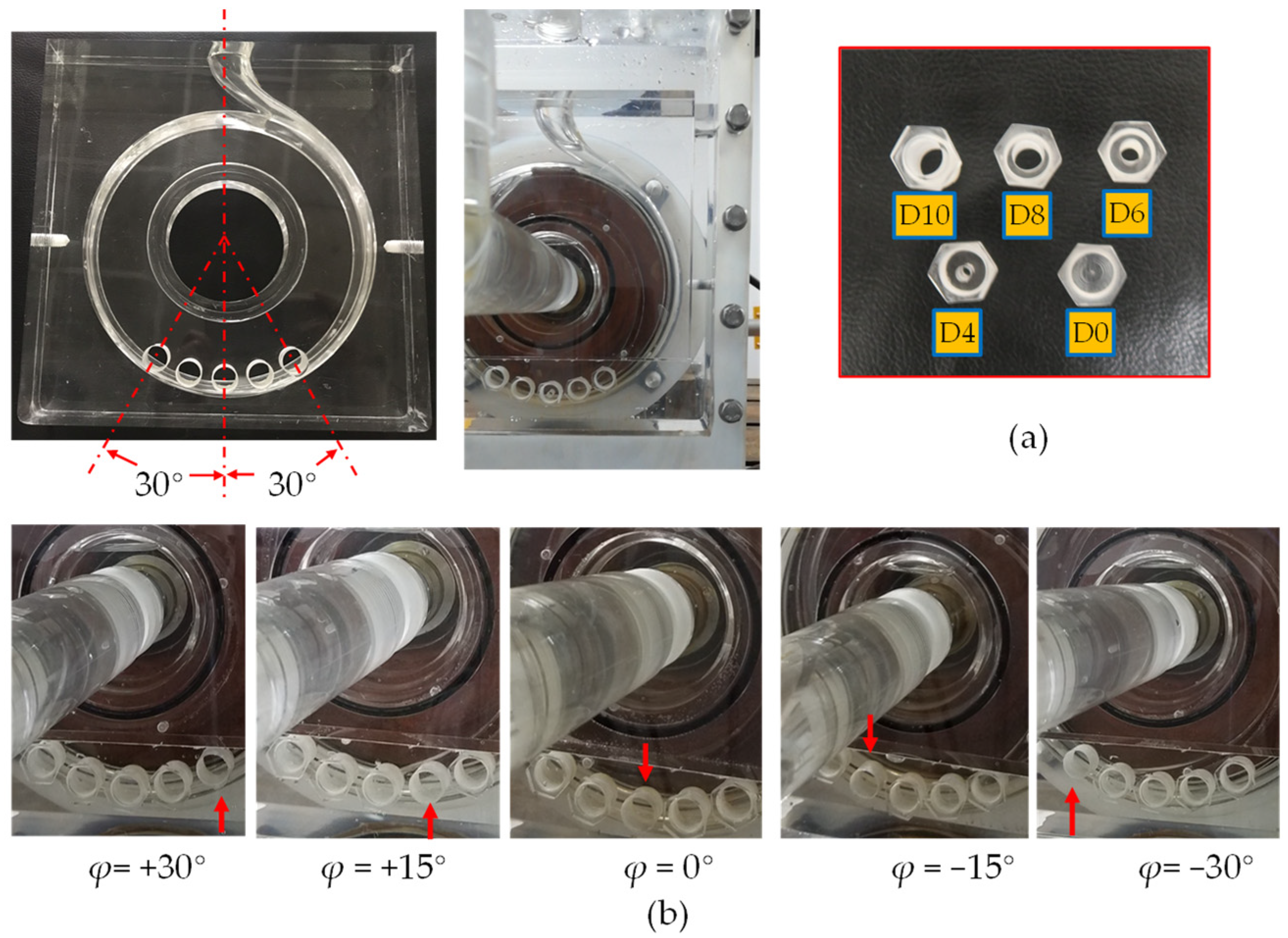
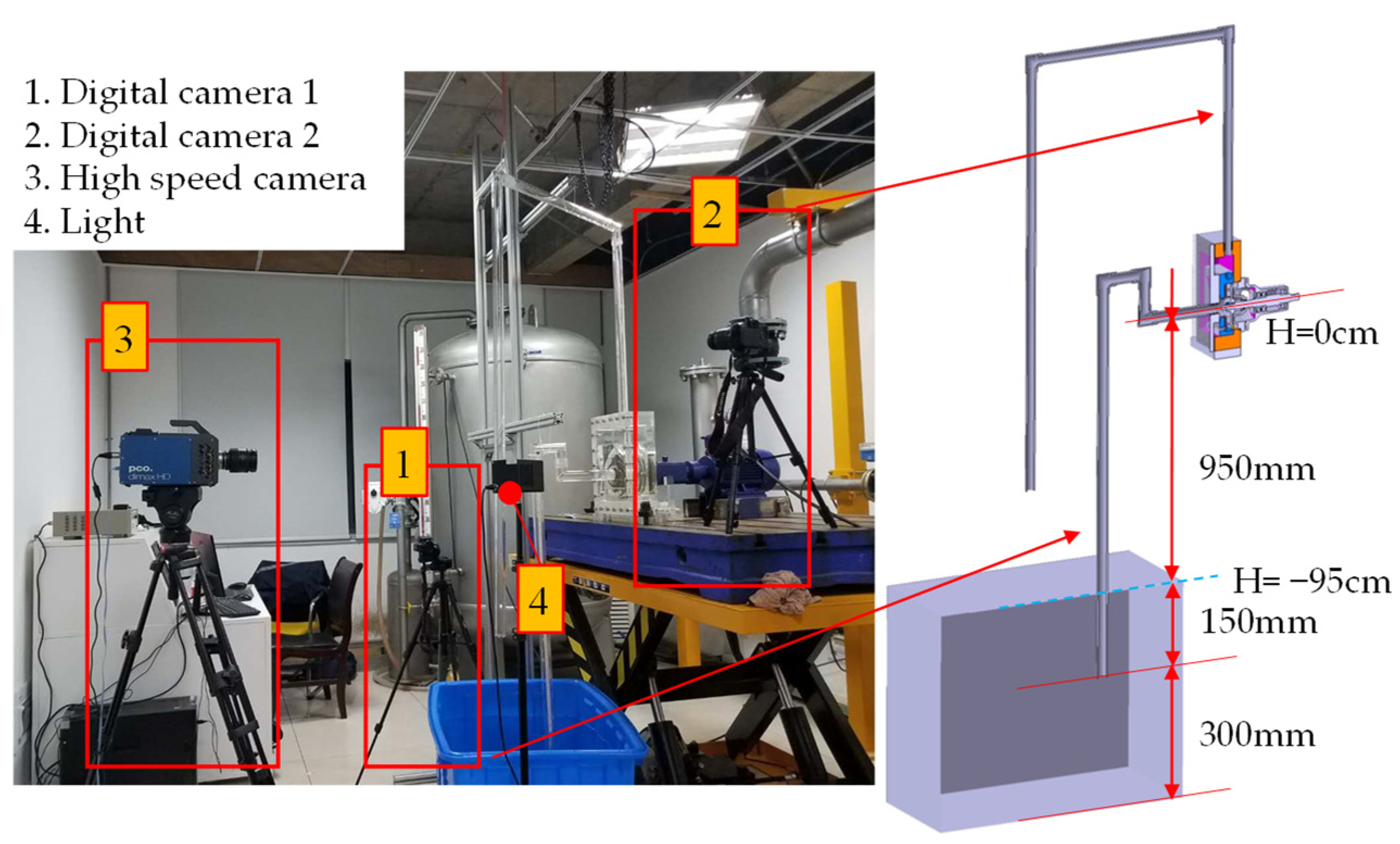
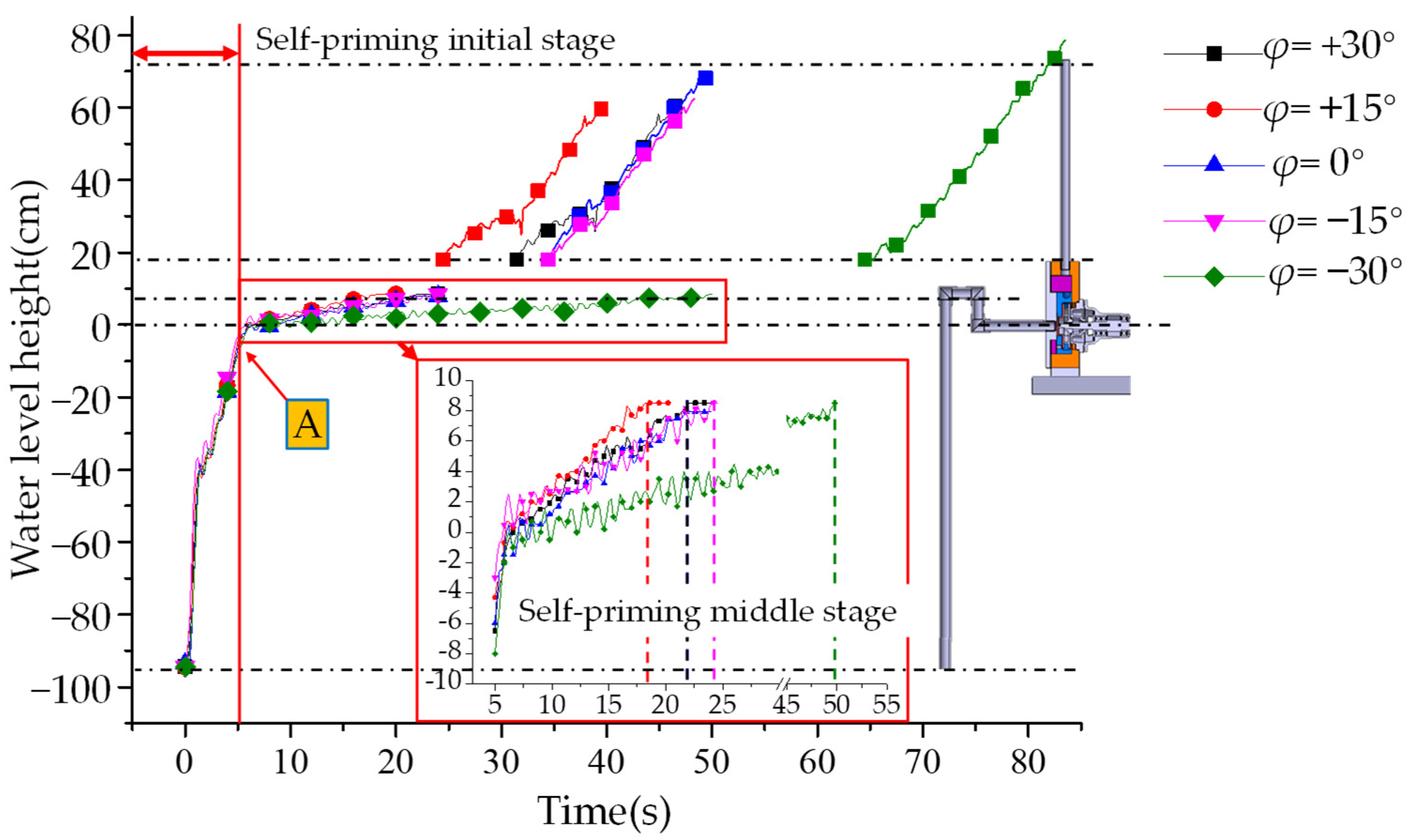
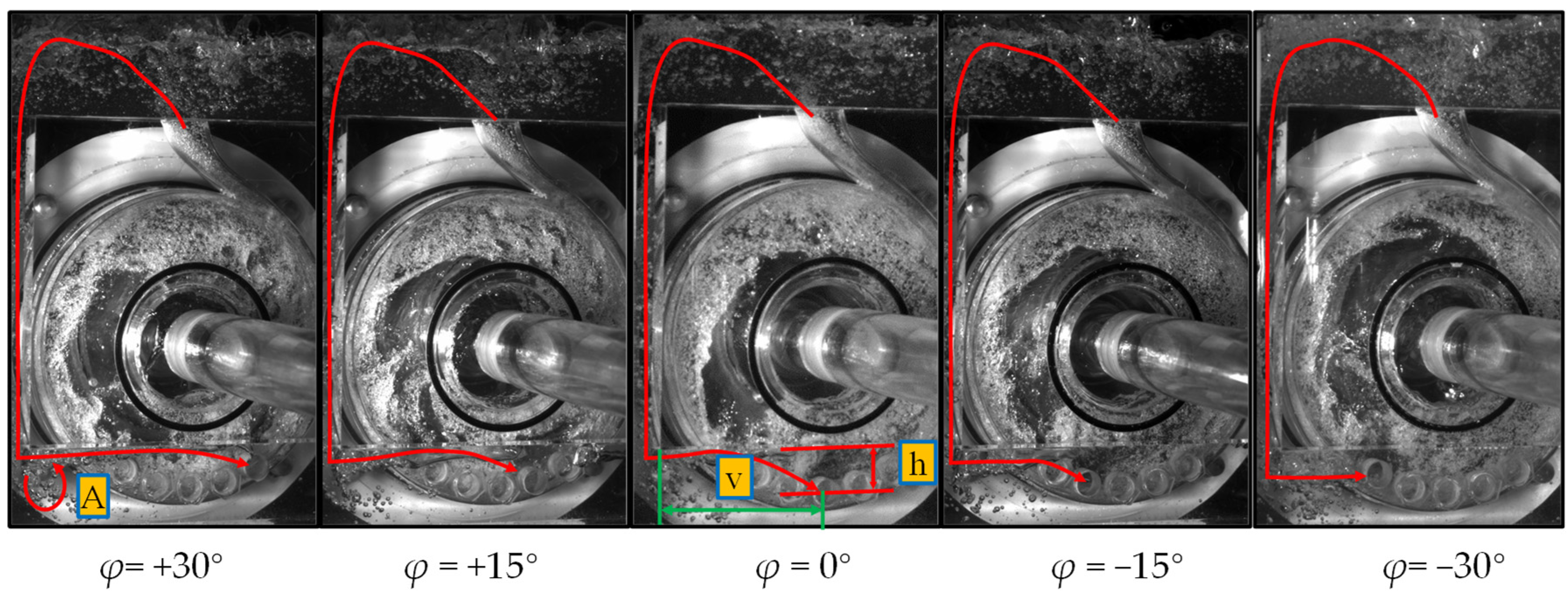
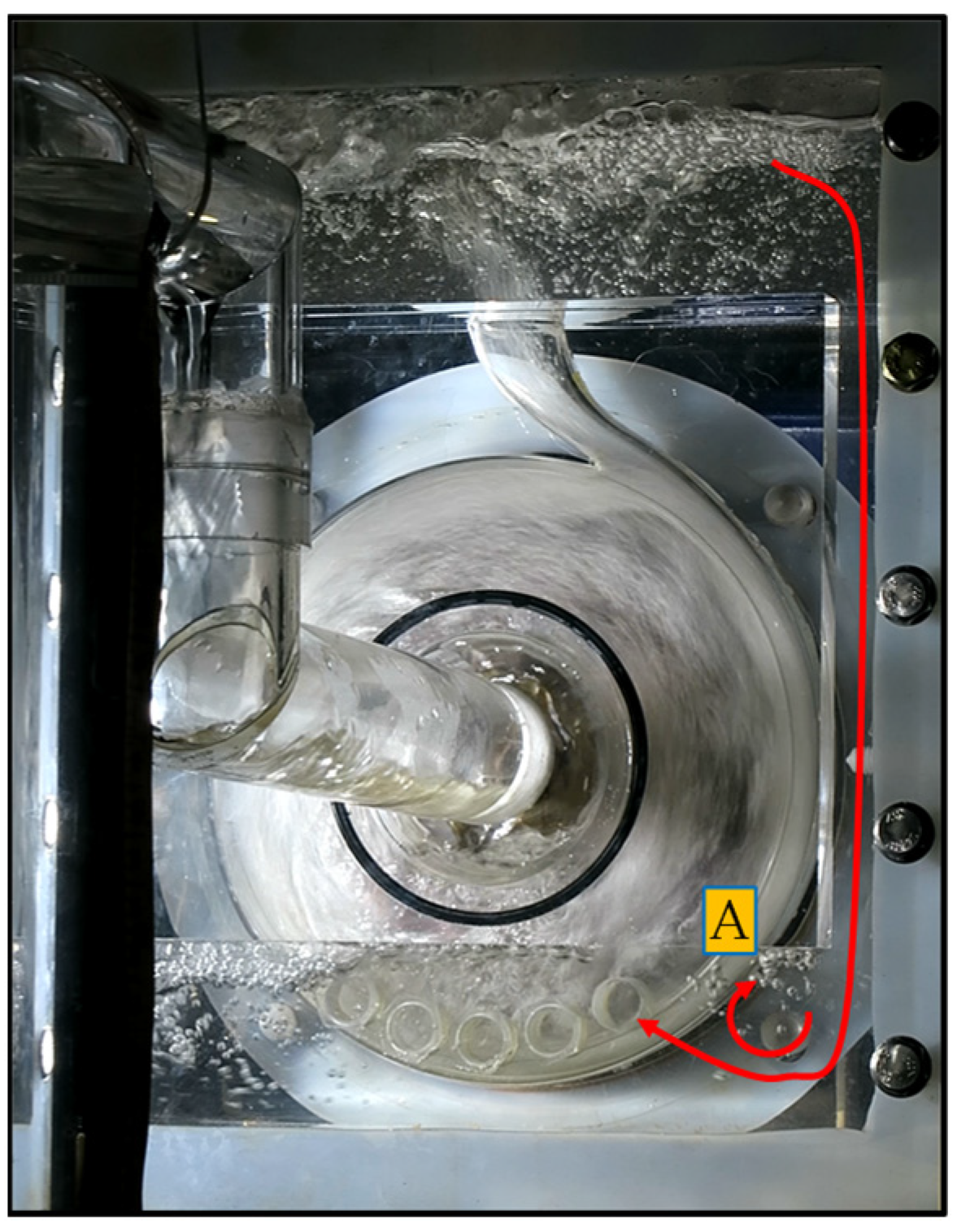


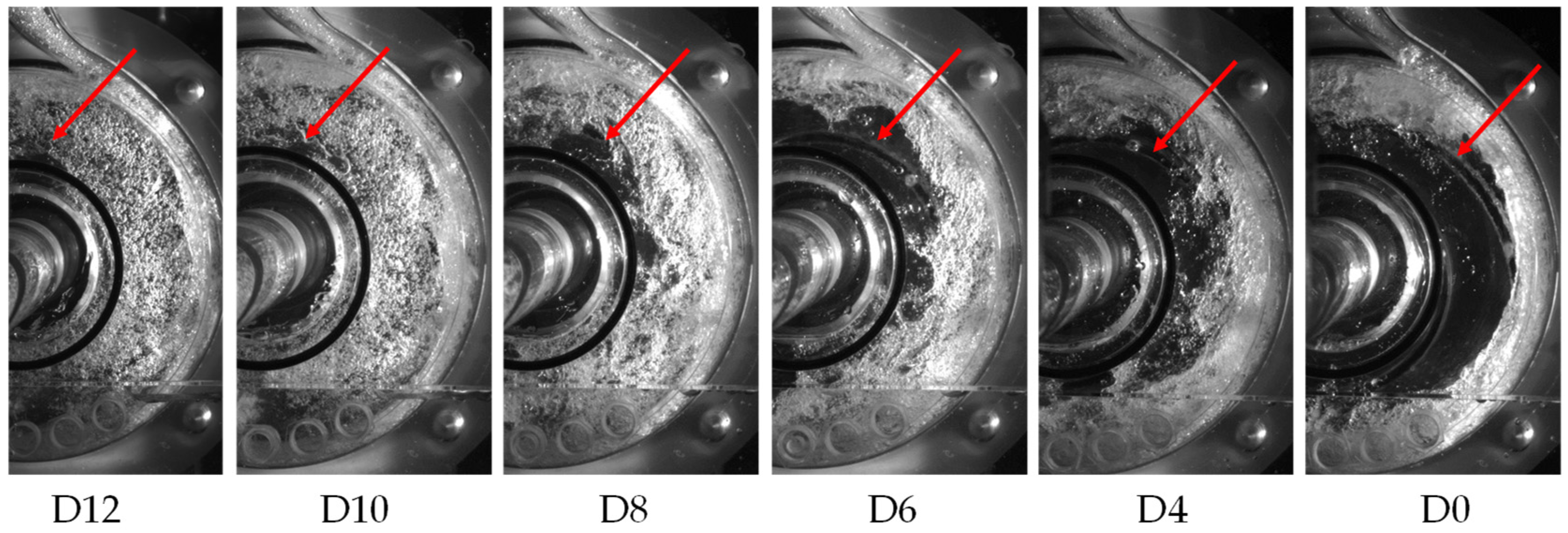
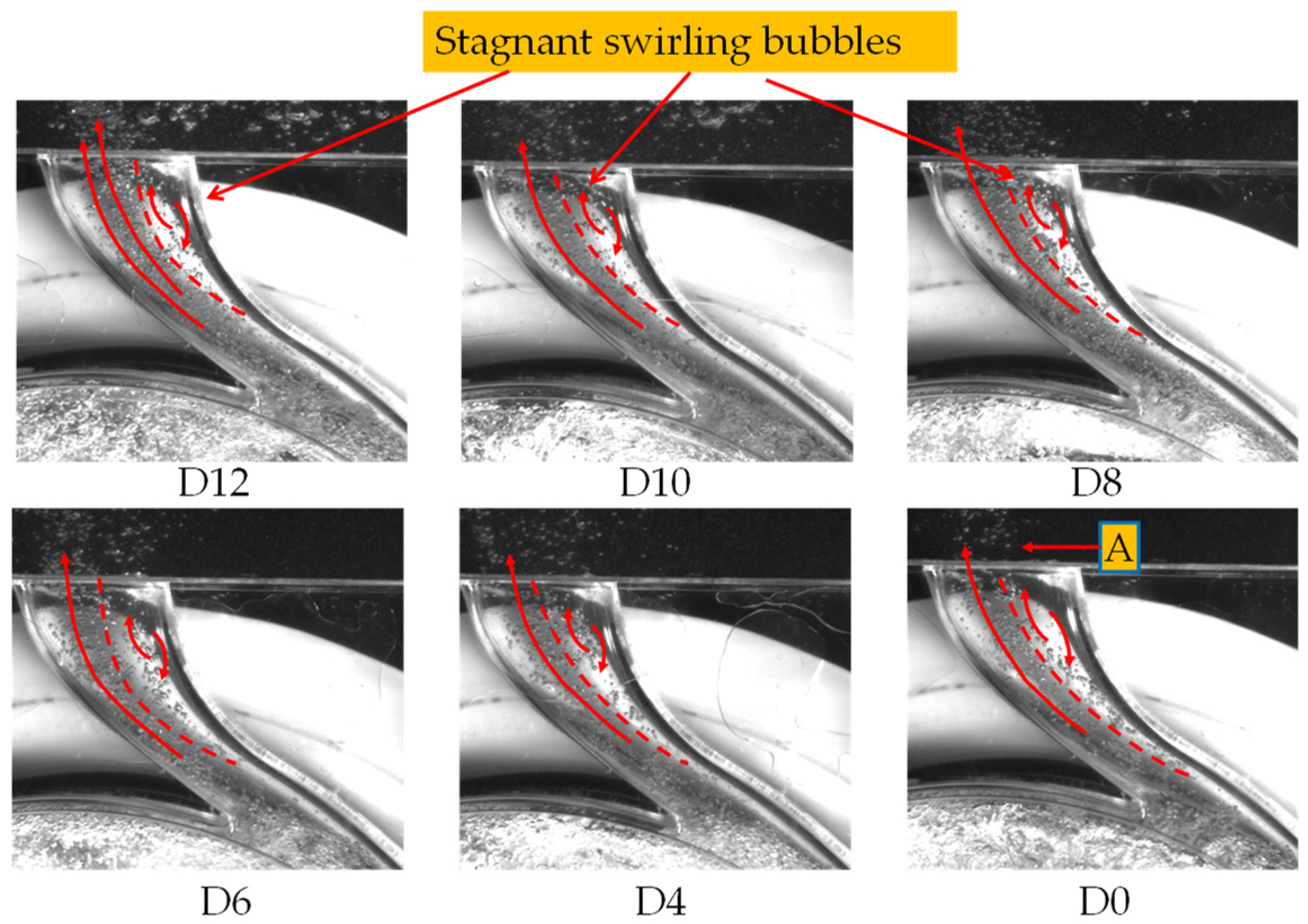
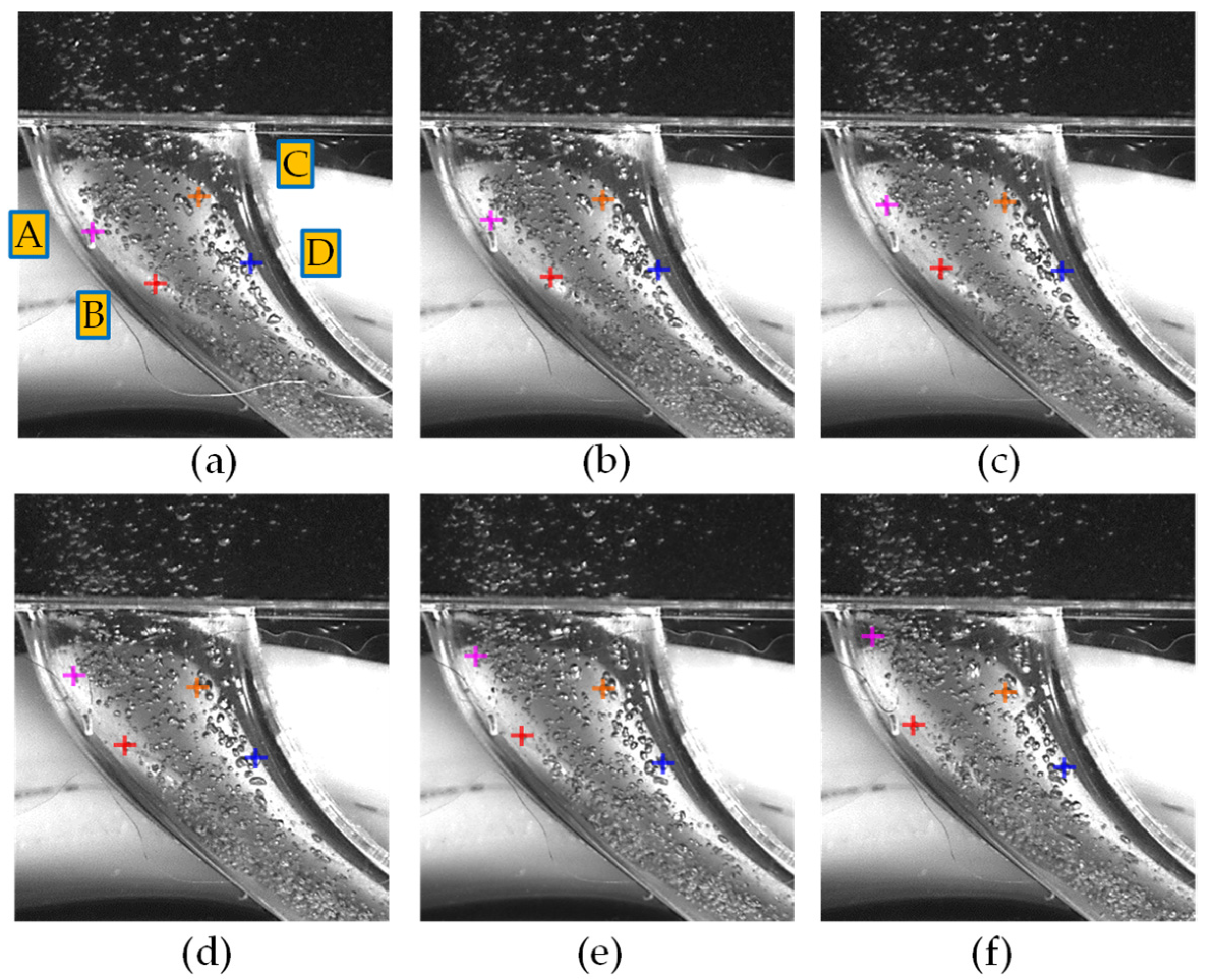
| Parameter | Value |
|---|---|
| Model pump | |
| Flow rate Qd (m3/h) | 5 |
| Total head Hd (m) | 6 |
| Rotation speed n (r/min) | 1680 |
| Specific speed nq | 59.6 |
| Impeller inlet diameter D1 (mm) | 60 |
| Impeller outlet diameter D2 (mm) | 158 |
| Blade outlet width b2 (mm) | 16 |
| Number of blades z | 2 |
| Warp angle φ (deg) | 255 |
| Area of reflux hole S (mm2) | 113 |
| High speed camera | |
| Sensor type | CMOS |
| Maximum resolution | 1920 × 1080 |
| Pixel size (μs) | 11 × 11 |
| Maximum frame rate (full resolution) (fps) | 2128 |
| Exposure time (ms) | 0.0015–40 |
| Pixel scan speed (MHz) | 55 |
| RAM (GB) | 36 |
| Interframe space (μs) | 3.15 |
Publisher’s Note: MDPI stays neutral with regard to jurisdictional claims in published maps and institutional affiliations. |
© 2022 by the authors. Licensee MDPI, Basel, Switzerland. This article is an open access article distributed under the terms and conditions of the Creative Commons Attribution (CC BY) license (https://creativecommons.org/licenses/by/4.0/).
Share and Cite
Qian, H.; Wu, D.; Xiang, C.; Jiang, J.; Zhu, Z.; Zhou, P.; Mou, J. A Visualized Experimental Study on the Influence of Reflux Hole on the Double Blades Self-Priming Pump Performance. Energies 2022, 15, 4617. https://doi.org/10.3390/en15134617
Qian H, Wu D, Xiang C, Jiang J, Zhu Z, Zhou P, Mou J. A Visualized Experimental Study on the Influence of Reflux Hole on the Double Blades Self-Priming Pump Performance. Energies. 2022; 15(13):4617. https://doi.org/10.3390/en15134617
Chicago/Turabian StyleQian, Heng, Denghao Wu, Chun Xiang, Junwei Jiang, Zhibing Zhu, Peijian Zhou, and Jiegang Mou. 2022. "A Visualized Experimental Study on the Influence of Reflux Hole on the Double Blades Self-Priming Pump Performance" Energies 15, no. 13: 4617. https://doi.org/10.3390/en15134617






